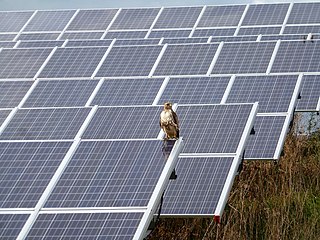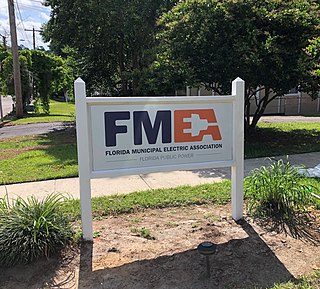The Central Electricity Generating Board (CEGB) was responsible for electricity generation, transmission and bulk sales in England and Wales from 1958 until privatisation of the electricity industry in the 1990s.

The electricity sector in Canada has played a significant role in the economic and political life of the country since the late 19th century. The sector is organized along provincial and territorial lines. In a majority of provinces, large government-owned integrated public utilities play a leading role in the generation, transmission, and distribution of electricity. Ontario and Alberta have created electricity markets in the last decade to increase investment and competition in this sector of the economy.

The Electric Reliability Council of Texas, Inc. (ERCOT) is an American organization that operates Texas's electrical grid, the Texas Interconnection, which supplies power to more than 25 million Texas customers and represents 90 percent of the state's electric load. ERCOT is the first independent system operator (ISO) in the United States. ERCOT works with the Texas Reliability Entity (TRE), one of six regional entities within the North American Electric Reliability Corporation (NERC) that coordinate to improve reliability of the bulk power grid.

The State Electricity Commission of Victoria is a government-owned electricity company in Victoria, Australia. Originally established to generate electricity from the state's reserves of brown coal, the SEC gradually monopolised most aspects of the Victorian electricity industry, before being broken up and largely privatised in the 1990s. After several decades of dormancy, it was revived in 2023 to invest in renewable energy and storage markets.
Silicon Valley Power (SVP) is a not-for-profit municipal electric utility owned and operated by the City of Santa Clara, California, United States. SVP provides electricity service to approximately 55,116 residential and business customers, including large corporations such as Intel, Applied Materials, Owens Corning and NVIDIA. SVP also owns and maintains a dark fiber network named SVP Fiber Enterprise.

The Calcutta Electric Supply Corporation (CESC) is the Kolkata-based flagship company of the RP-Sanjiv Goenka Group, born from the erstwhile RPG Group, under the chairmanship of businessman Sanjiv Goenka. It is an Indian electricity generation and the sole distribution company serving 567 square kilometres (219 sq mi) of area administered by the Kolkata municipal corporation, in the city of Kolkata, as well as parts of Howrah, Hooghly, 24 Parganas (North) and 24 Parganas (South) districts in the state of West Bengal. It also serves power distribution in Kota, Bikaner and Bharatpur in Rajasthan under the name CESC RAJASTHAN. It serves 3.0 million consumers approximately, which includes domestic, industrial and commercial users.
Santee Cooper, also known officially from the 1930s as the South Carolina Public Service Authority, is South Carolina's state-owned electric and water utility that came into being during the New Deal as both a rural electrification and public works project that created two lakes and cleared large tracts of land while building hydro-electric dams and power plants. Its headquarters are located in Moncks Corner, South Carolina.

The Tanzania Electric Supply Company Limited (TANESCO) is a Tanzanian parastatal organisation established in 1964. It is wholly owned by the government of Tanzania. The Ministry of Energy and Minerals regulates the operations of TANESCO.
Energy Northwest is a public power joint operating agency in the northwest United States, formed 67 years ago in 1957 by Washington state law to produce at-cost power for Northwest utilities. Headquartered in the Tri-Cities at Richland, Washington, the WPPSS became commonly known as "Whoops!", due to over-commitment to nuclear power in the 1970s which brought about financial collapse and the second largest municipal bond default in U.S. history. WPPSS was renamed Energy Northwest in November 1998, and agency membership includes 28 public power utilities, including 23 of the state's 29 public utility districts.
The Florida Public Service Commission (FPSC) regulates investor-owned electric, natural gas, and water and wastewater utilities. The FPSC facilitates competitive markets in the telecommunications industry, has authority over intercarrier disputes, and oversees pay telephones, the federal Lifeline Assistance Program and Telecommunications Relay Service.

Delhi Transco Limited (DTL), formerly Delhi Power Supply Company Limited (DPSCL) is the State Transmission Utility for the National Capital Territory of Delhi. It is responsible for the transmission of power at 220 kV and 400 kV level and for upgrading, operating and maintaining the high voltage network.
New York has 2,192 MW of installed wind power capacity as of 2022. Most of New York's wind power is located in upstate New York as onshore wind farms. New York has set a goal of developing 9,000 MW of offshore installed wind power capacity by 2035 that will power an estimated 6 million homes. As of October 2022, New York has five offshore wind farms in development with approximately 4,300 MW installed capacity.
The National Association of Regulatory Utility Commissioners (NARUC) is the national association representing the U.S. state public service commissioners who regulate essential utility services, including energy, telecommunications, and water. Founded in 1889, the Association is a resource for its members and the regulatory community, providing a venue to set and influence public policy, share best practices, and foster solutions to improve regulation.
The Grand River Dam Authority (GRDA) is an agency of the state of Oklahoma created to control, develop, and maintain the Grand River waterway. It was created by the Oklahoma state legislature in 1935, and is headquartered in Tulsa, Oklahoma. GRDA was designed to be self-funding from the sales of electricity and water. The state of Oklahoma was to provide no funding from taxes. The Authority was authorized to issue revenue bonds to fund large-scale capital investments.

Solar power in Michigan has been growing in recent years due to new technological improvements, falling solar prices and a variety of regulatory actions and financial incentives. The largest solar farm in Michigan is Assembly Solar, completed in 2022, which has 347 MW of capacity. Small-scale solar provided 50% of Michigan solar electricity as recently as 2020 but multiple solar farms in the 100 MW to 200 MW range are proposed to be completed by the middle of the decade. Although among the lowest U.S. states for solar irradiance, Michigan mostly lies farther south than Germany where solar power is heavily deployed. Michigan is expected to use 120 TWh per year in 2030. To reach a 100% solar electrical grid would require 2.4% of Michigan's land area to host 108 GW of installed capacity.

Solar power in Vermont provides almost 11% of the state's in-state electricity production as of 2018. A 2009 study indicated that distributed solar on rooftops can provide 18% of all electricity used in Vermont. A 2012 estimate suggests that a typical 5 kW system costing $25,000 before credits and utility savings will pay for itself in 10 years, and generate a profit of $34,956 over the rest of its 25-year life.

The Florida Municipal Electric Association (FMEA) is the non-profit trade association representing the unified interests of Florida’s 33 public power communities.

The Kansas City Board of Public Utilities (BPU) is a publicly owned, not-for-profit public utility servicing Wyandotte County that is headquartered in Kansas City, Kansas. Overall, BPU provides service to 127.5 square miles of Wyandotte County. Electric services are provided within the Kansas City, Kansas (KCK) area, and water is supplied to KCK, as well as portions of suburban Wyandotte, Leavenworth, and Johnson counties.
The Delaware Municipal Electric Corporation (DEMEC) is a Joint Action Agency and wholesale electric utility that represents nine municipal electric departments in the state of Delaware in the United States. The agency, which was created in 1979, is headquartered in Smyrna.










